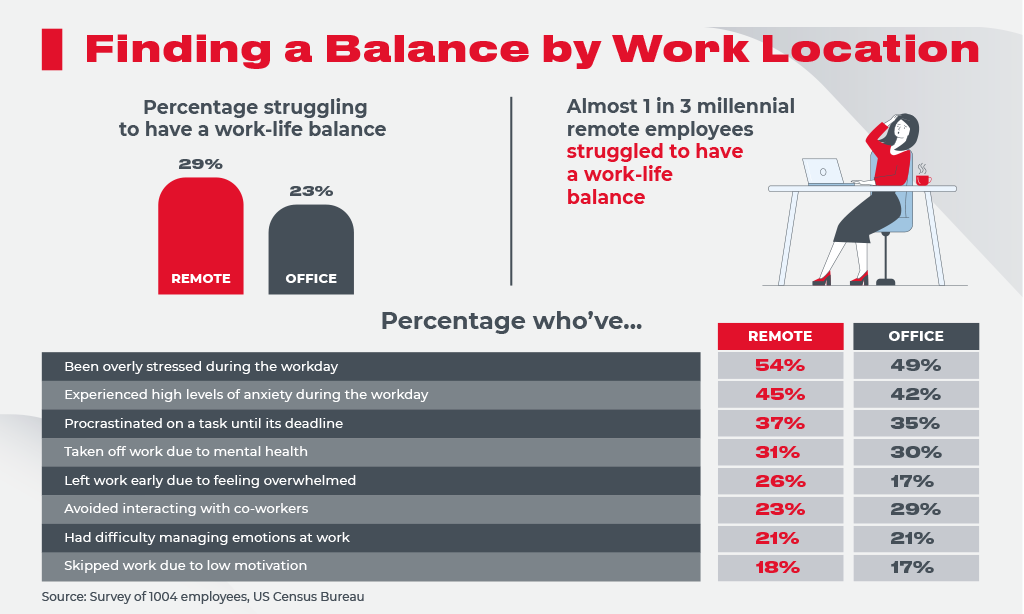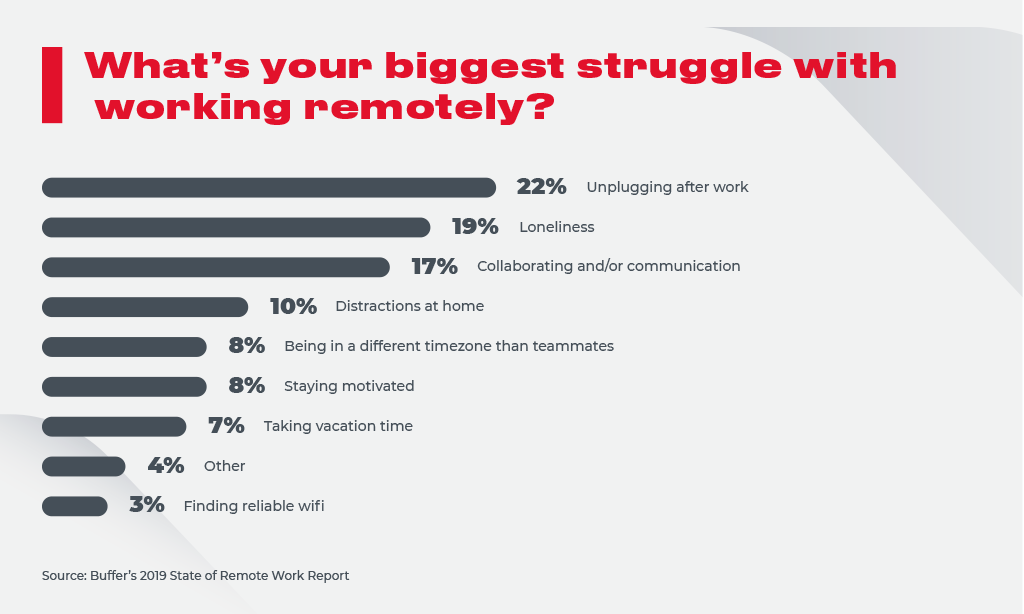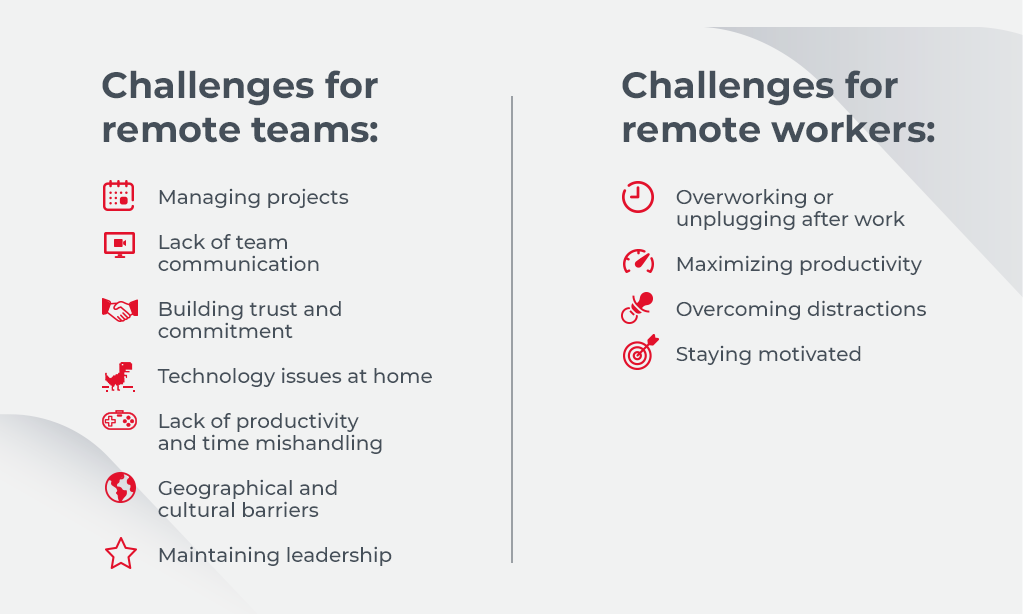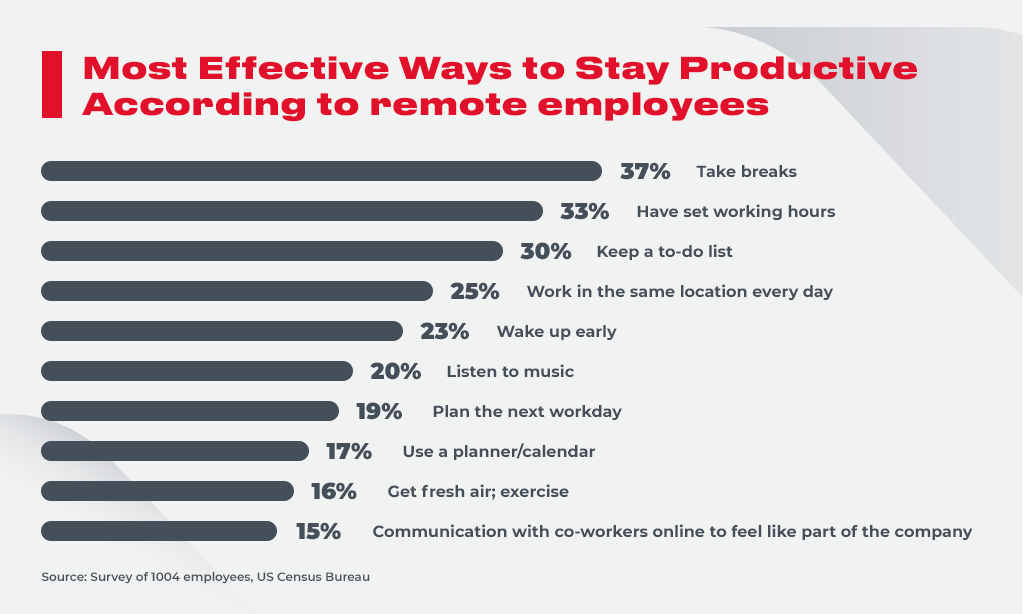11 Remote Work Challenges and Ways to Cope with Them
The remote work is the new normal. The current situation when the pandemic is spread worldwide is another reason to start searching for an out-of-office job.
Studies demonstrate that remote workers are more productive, healthier and have a more positive work-life balance. They typically take fewer days off sick, stay motivated for longer, stay in their jobs for longer and prefer their freedom over wage increases.

Remote work sounds like the revolution of the 2000s, but it’s not something you can simply switch to and hope for the best. As with anything, there are many challenges to overcome, as well. In this article, we’re looking at remote work challenges and how we overcome them.
Top 11 Challenges of Working From Home
Despite the benefits remote employees enjoy, there is a number of problems that arise from working out of the office. As the 2019 State of Remote Work report by Buffer states, the most common problem is overworking or unplugging after work. In essence, an issue 22% of respondents said they experience.

Loneliness is the second problem (19%). In comparison, collaboration (17%), distractions at home (10%), time zones (8%) and staying motivated (8%) are all concerns that worry remote workers and their companies.
Meanwhile, another study conducted by Hubstaff finds the biggest challenges for companies with remote teams comprise communication, scheduling, tracking performance and cultural barriers. Another problem it states is building and keeping trust between remote team members.

We also provide solutions to these problems, based on methods we use at Innovecs, other companies’ practices and recommendations of scientific studies. Let’s begin with the most common remote work challenges for teams.
Challenges for Remote Teams and Ways to Overcome Them
Challenge 1. Managing Projects
The biggest problem with out-of-office work is managing projects. Whether it’s a combination of in-house and remote staff or an entire group of remote workers, managers have to make sure deadlines are met and goals are achieved.
Without having the opportunity to see each other in real life, communication becomes more difficult and tracking individual tasks is questionable, especially for large teams.
Solution
Asana is an all-in-one team management platform. It offers a broad spectrum of team management features, such as advanced permissions and dedicated pages for teams and the ability to chat at the task, project and team level.
What platform to choose is up to a business to decide. There is an excellent assortment of other software like Trello, designed for teams with less critical needs. Once proper software is found, the company’s C-level executives should make sure they have the right management in place.
Challenge 2. Lack of Team Communication
Another issue the remote teams report in surveys is a communication from different locations. How can a team of developers work on the same project when they live in another city or country, for instance? When team members work in the same office, they can interact with each other without any limitations.
Solution
The first thing needed for the remotely working team is an effective communication channel. Gmail or any other email provider isn’t an adequate tool to manage remote team communication. Virtual teams require something instant, responsive, and flexible.
Slack has recommended itself as the go-to communication program perfectly suitable for remote teams collaboration. It provides all the necessary features – from instant messaging to availability statuses, notifications, file sharing, group chats, and more. It has a user-friendly interface that new team members can join with quick email signup.
For essential document sharing and collaboration, there is an easy-to-use Google Drive. For the design teams, tools like InVision make collaborative prototyping possible for remote teams. Another option to choose is MS Office 365 (with communication tool MS Teams), allowing cooperating with colleagues for free if using a web version.
Challenge 3. Building Trust and Commitment
Just like communication problems, mistrust may arise among on-site or remote teams alike. This feeling may appear when we feel that our co-workers are not committed enough to the project as expected. Lack of engagement may also take place when we don’t feel motivated enough or identified with the team.

Solutions
Keep a clear vision of your company. Set the right objectives for your company. This will help to create identification channels with your colleagues. As an example, Netflix’s mission is to become the best global entertainment service and to promise its collaborators a chance to make a significant contribution.
At Innovecs, a lot of our employees work remotely because of the quarantine measures, but we all pursue a common goal. Now the mission we work for every day is to transform the workplace and continue working on great projects delivering high-quality products to global companies.
What we do is, for example, sharing with colleagues Innovecs Learning Digest. It guides through tips to work effectively and collaboratively with your team, be it at home or on the other side of the planet.
Develop remote-leadership skills. Social scientists on the field of entrepreneurial performance, Joseph Grenny and Daniel Maxfield believe that getting rid of mistrust in virtual teams is up to leadership. Later we will discuss some essential skills a good team leader should have to work with remote collaborators.
Challenge 4. Technology Issues At Home
To work remotely, one has to be tech-savvy to some extent. And this applies not only to the devices, like a laptop, tablet, or smartphone but to different types of apps, software, etc. It’s essential to choose wisely and leverage only such tech which is necessary for the job.
Solution
Before using any tool, app, or software, conduct in-depth research on whether it’s relevant to exploit. Very often, employees buy equipment or devices which are not obligatory in their work. It only grabs a lot of attention, but will not necessarily make work efficient and bring closer to optimizing it.
- Train all your staff to use technology
- Invest in adequate technology
- Ensure your team has the right tools they need
- Keep updated and invest in new tech
Challenge 5. Lack of Productivity and Time Mishandling
Many businesses view home-based work as a threat to controlling their employees. It is no news to see some individuals not using time assertively when they are not under constant control.
Solution
The web programs such as Asana, Jira, or Trello allow tracking what the employees are doing at the current moment, what tasks they have as well as deadlines.
Team members, in turn, can see what everyone else is currently working on, what they got up to yesterday, any “blockers” that are getting in the way of completing tasks. This means no disruptions when people are working on something important.
RescueTime is a tool that identifies the wasted time. The software tracks the time spent in apps, unveiling how many minutes are lost to social media or other apps that often destroy productivity. It can also do the same for specific websites inside browser apps to show which pages are stopping progress.
Challenge 6. Geographical and Cultural Barriers
According to scientists Blaise Bergiel, Erich Bergiel, and Phillip Balsmeier, remote working team members from different countries may also pose particular challenges like a language barrier or cultural differences.
Solutions
Let’s look at this issue from the managers’’ perspective. Here are some tips for project leaders:
Make your candidates pass the exam on the language in which they communicate. Provide training and courses for prospects and current workers as well. This helps them to improve their communication skills in technical aspects or use experienced translators.
Set up delivery schedules with deadlines. This tip will allow remote workers to not wait for hours to go on with their work.
Establish an atmosphere of respect, openness, and empathy. Get closer to your colleagues for them to feel trusting about sharing with you the cultural barriers they may be facing.
Challenge 7. Maintaining Leadership
Inadequate leadership is one of the main problems virtual teams face. Many business professionals may be great face-to-face leaders but have not acquired the skills needed to practice remote leadership.
Solution
In the Harvard University survey, participants described the skills of a particularly great manager when dealing with remote working teams:
- Frequent and consistent feedback: good remote working team leaders give consistent and personal input at least once a week.
- Face-to-face or verbal communication: good project leaders conduct video-calls or at least phone calls with teammates whenever important subjects need discussion.
Outstanding communication skills: they can perfectly convey complex ideas, specific expectations, abounding information and set constant motivation to all the home-based workers. They listen, cast confidence, respect and are personally concerned about their fellow teammates.
Challenges for Remote Workers and Ways to Overcome Them
Challenge 8. Overworking or Unplugging After Work
Although a remote job offers more flexibility, some people tend to spend much more time on work than is required. Rest deprivation, exhaustion, lack of private time are just a few of the adverse effects.
Solutions
To prevent overworking, one can follow the below-listed tips:
- Tracking work time. With the use of software, a remote worker can determine how many hours are spent on work and limit the time to the most useful 8 hours per day.
- Prioritizing tasks. Checking the daily tasks and working on those with accurate descriptions and due dates.
- Organizing day implies taking breaks and setting the alarm clock for when it’s time to complete the work.
Setting availability statuses and notifications priority in apps like Slack and Status Hero to prevent disturbing when the working day is over.

Challenge 9. Maximizing Productivity
Low effectiveness is one of the most difficult challenges to overcome. The longer it takes to finish tasks, the more they occupy private life and the less productive a remote worker becomes.

Solutions
There’s a lot of scientific research studying this topic these days. There are also plenty of tools (RescueTime, Asana, Slack, Status Hero, etc.) designed to help businesses, teams, and individuals to maximize productivity.
So let’s take a scientific approach to solve this problem. Here are some key facts from researches that look into the most common productivity killers:
- Multitasking lowers productivity by up to 40%
- Performance starts to decrease after 50-60 minutes of continuous work
- It takes up to 24 minutes to regain focus after an interruption
Based on those scientific insights, here’s a simple three-step plan to maximize productivity:
- Avoid multitasking: Set a single goal for each day and focus on achieving that target.
- Take breaks: this helps to decompress and relax an overworked brain
- Get rid of distractions: Stop inessential distractions from killing productivity.
Implementing that three-step plan is surprisingly tricky – one has to reshape the mind and develop new working habits. Otherwise, you’ll instinctively get back to multitasking and other bad habits.
Challenge 10. Overcoming Distractions
Distractions appeared to be nightmares for every remote worker. Procrastination is one of the most common interruptions. When working from home, you can accomplish what you do not necessarily have to do while in the present moment – cleaning up an apartment, brushing a cat, etc. Distractions also come from family, as an example in the video below.
It’s crucial to create your own space to work peacefully, apart from distractions and equipped only with the necessary tools needed for the job. These tips aid in eliminating the distractions:
- Turn off smartphone during work
- Minimize social media activity
- Set blocks of time for every task
Challenge 11. Staying Motivated
Staying motivated is vital for remote workers. Without the presence of supervisors and team members, there’s less pressure to get things done, and one can also miss out on that group satisfaction of hitting targets as a team.
Solution
It’s important to talk about motivation with team leaders and colleagues. Some people have more natural motivation than others. What counts is doing everything collectively to maximize motivation for everyone.
Team leaders should be interested in the process of remote employees’ work, ask if anything bothers them, offer help in solving the particular issue. In other words, motivation highly depends on the remote worker itself as well as the entire team and management.
Summary: Find Your Perfect Remote Team
In a time where remote work is spreading at a rapid rate globally, we at Innovecs, are ready to transform our workplaces and help others at the same time. Here are the best solutions to stay productive:
- Trust your remote team members and encourage their motivation through constant communication, setting adequate deadlines, checking their moods and involving in online activities (webinars, training, games, etc.),
- Use modern tools for enhancing productivity, task management, work discussion (Asana, MS Office 365, Slack, etc.)
- Find balance in organizing work with teams from different locations. Every teammate should feel comfortable – be it an employee from India or France.
We mentioned only a few of the challenges of working from home. However, paying attention to them will make your remote team bring more results than you think. If your business is on the way to hire out-of-office specialists, Innovecs has a triumphant story of providing outsourcing services to companies worldwide.